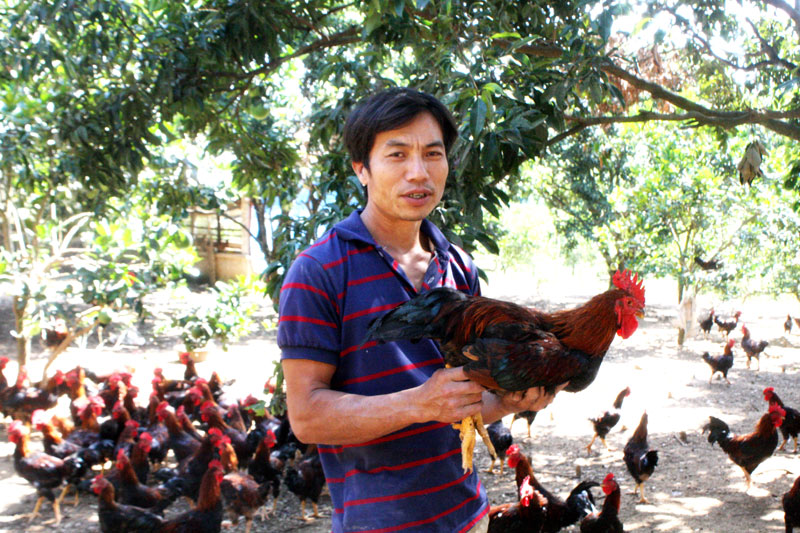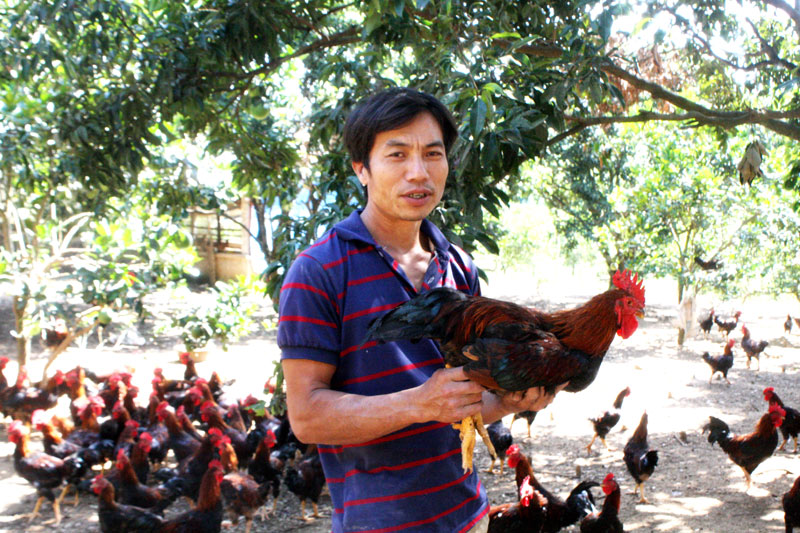
(HBO) - With a large hill garden and determination to get rich in the homeland, Tran Dinh Liem, a farmer in Dong De village, Dong Tam commune, Lac Thuy district, has reaped successes when putting his trust in Lac Thuy chickens.

Photo: Tran Dinh Liem in Dong De village, Dong Tam commune,
Lac Thuy district, has been successful thanks to the model of Lac Thuy chicken
farming.
In early 2010, Dong Tam commune strongly developed
chicken farming model in Lac Thuy. Many households have converted their gardens
and hills to farms to raise chickens. Lac Thuy chickens with delicious meat has
quickly become popular, opening up promising development opportunities for
local farmers.
Seeing high economic efficiency, Liem invested in
cages to raise chickens. On a flat and wide litchi garden, he used B40 steel
mesh divided into six areas to breed chickens.
In the first batch, he raised 3,000 hatches.
Despite difficulties such as the lack of experience in caring and preventing
epidemics for chickens, he still achieved successes. The first batch of
chickens was sold at high prices, giving him more capital to expand farming.
"It is a local variety which must be raised
free-range so that a large area is needed. I raise chickens and learn
experience from other households, books and newspapers so I do not meet much
difficulties”, Liem said.
According to him, his family raised up to 12,000
chickens at the highest per batch. Now, there are 4,000 chickens which could be
sold in the next 10 days. Apart from raising chickens for meat, he raises another
2,000 for laying eggs. Last year, he sold nearly 7 tonnes of chicken, earning
roughly 300 million VND. He is raising 2,000 breeding chickens.
"Compared to other fowls, Lac Thuy chicken is
quite appropriate because it is popular in the market. There are many farming
households but their connectivity is weak. For sustainable results, we hope to
establish a cooperative for mutual support and improve Lac Thuy chicken
trademark”, Liem said./.
According to data from the Hoa Binh Provincial Party Committee, the industrial production index for the first six months of 2025 is estimated to have increased by 20% compared to the same period last year. This marks the highest year-on-year growth rate for this period since 2020.
In the first six months of 2025, Hoa Binh province’s export turnover was estimated at 1.145 billion USD, marking an 18.11% increase compared to the same period in 2024. Import turnover was estimated at $ 804 million, a 17.15% increase, which helped the province maintain a positive trade balance.
The lives of the ethnic minority farmers in Tan Lac district have gradually improved thanks to the new directions in agricultural production. This is a testament to the collective strength fostered through the professional associations and groups implemented by various levels of the district’s Farmers’ Union.
With the motto the "product quality comes first,” after nearly one year of establishment and operation, Muong village’s Clean Food Agricultural and Commercial Cooperative, located in Cau Hamlet, Hung Son Commune (Kim Boi district), has launched reputable, high-quality agricultural products to the market that are well-received by consumers. The products such as Muong village’s pork sausage, salt-cured chicken, and salt-cured pork hocks have gradually carved out a place in the market and they are on the path to obtaining the OCOP certification.
In the past, the phrase "bumper harvest, rock-bottom prices" was a familiar refrain for Vietnamese farmers engaged in fragmented, small-scale agriculture. But today, a new spirit is emerging across rural areas of Hoa Binh province - one of collaboration, organisation, and collective economic models that provide a stable foundation for production.
Maintaining growing area codes and packing facility codes in accordance with regulations is a mandatory requirement for agricultural products to be eligible for export. Recently, the Department of Agriculture and Environment of Hoa Binh province has intensified technical supervision of designated farming areas and packing facilities to safeguard the "green passport" that enables its products to access international markets.



